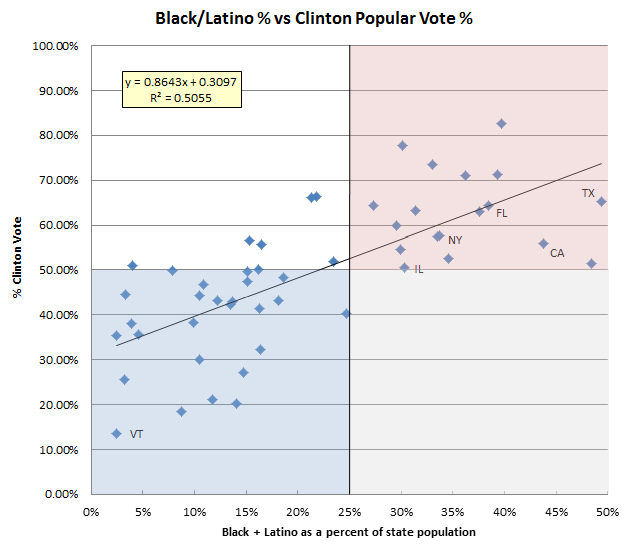To win within the Republican Party, one must appeal to rural and exurban populations, where the conservative base lives. To win within the Democratic Party, you have to win in the cities, especially those in high-population states with significant ethnic populations. Ultimately, this is what the Sanders campaign failed to do.

The lower-right quadrant (colored in gray) represents Sanders’ victories in states with more than 25% combined Black and Latino populations. In order to win the nomination, Sanders needed to wind up with a few states in that quadrant, particularly delegate-rich states such as California, Texas, Florida, New York, and Illinois. For reasons which remain somewhat obscure, this proved to be something he could not do.
Another way to see the pattern is to consider the primary results at a county by county level.

|
Map of the Democratic Party (United States) presidential primaries, 2016 by county/popular vote margin. Sanders—>90%
Sanders—80–90%
Sanders—70–80%
Sanders—60–70%
Sanders—50–60%
Sanders—<50%
Tie
Clinton—<50%
Clinton—50–60%
Clinton—60–70%
Clinton—70–80%
Clinton—80–90%
Clinton—>90%
|
You can see several orange-tinted urban splotches where Clinton wins even when surrounded by a sea of Sanders green, such as the metropolitan areas around Chicago, Oklahoma City, Indianapolis, Milwaukee, Boston, and Detroit. Lightly populated upstate New York is almost uniformly green, whereas New York City itself went heavily the other way. Outstandingly white states such as Vermont, New Hampshire, Maine, and West Virginia went entirely for Sanders at the county level.
Some will argue that Sanders supporters are more distinguishable in terms of age (i.e. youth) rather than ethnicity, but when it comes to winning elections, that factor tends to wash out. Some states are a bit younger than others on average, but their population pyramids (visual stacking by age cohort) are not terribly different and none of them are composed primarily of youthful voters. Heterogeneity in ethnicity is enough to swing elections at a state or district level (where it counts) but the composition by age doesn’t vary nearly so much.
As to the question why Sanders didn’t capture the imagination of most people of color, I can posit a few probable factors. Firstly, the Clintons have had more than a two decade head-start building relationships with Black America, whereas Sanders hails from the whitest state in the nation and only became a national figure in the last year or so. Secondly, Hillary Clinton is perceived as the successor to Barack Obama, she is the only candidate who served on his team and the one most likely to continue his policies in a minimally altered form. (Sanders’ take-no-prisoners oratorical style and his radical proposals for immediate change could hardly be further from the “no drama Obama” approach to governance, which is essentially pragmatic and gradualist.) Finally, there is Sanders’ mixed record on gun regulation, which may well raise eyebrows in those parts of the nation most plagued by gun violence, that is, our urban centers.
There may well be other reasons which explain the demographic voting patterns of the last several months. If you’ve any ideas, please leave a comment below.
[Featured image by Donkey Hotey, reproduced under Creative Commons 2.0 attribution license]
